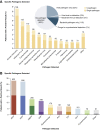Epidemiology of Viral Pneumonia
- PMID: 28159152
- PMCID: PMC7115731
- DOI: 10.1016/j.ccm.2016.11.012
Epidemiology of Viral Pneumonia
Abstract
The burden of pneumonia, including that due to respiratory viruses, is markedly higher in the very young (<5 years) and older adults (≥50 years). Respiratory viruses substantially contribute to pneumonia in both adults and children, and when systematically tested for, are more commonly detected than bacteria in both adults and children. It is difficult to distinguish between viruses by clinical presentation, and the exact clinical implication of viral detections among patients with pneumonia depends on the pathogen detected; however, there is increasing evidence of their importance in pneumonia.
Keywords: Epidemiology; Pneumonia; Respiratory viruses.
Published by Elsevier Inc.
Figures


Similar articles
-
Community-acquired pneumonia in Chile: the clinical relevance in the detection of viruses and atypical bacteria.Thorax. 2013 Nov;68(11):1000-6. doi: 10.1136/thoraxjnl-2013-203551. Epub 2013 Jun 19. Thorax. 2013. PMID: 23783373
-
The role of respiratory viral infections among children hospitalized for community-acquired pneumonia in a developing country.Pediatr Infect Dis J. 2008 Oct;27(10):939-41. doi: 10.1097/INF.0b013e3181723751. Pediatr Infect Dis J. 2008. PMID: 18756190
-
Viral etiology of community-acquired pneumonia among adolescents and adults with mild or moderate severity and its relation to age and severity.BMC Infect Dis. 2015 Feb 22;15:89. doi: 10.1186/s12879-015-0808-0. BMC Infect Dis. 2015. PMID: 25812108 Free PMC article.
-
Influenza and Viral Pneumonia.Clin Chest Med. 2018 Dec;39(4):703-721. doi: 10.1016/j.ccm.2018.07.005. Clin Chest Med. 2018. PMID: 30390743 Free PMC article. Review.
-
Mixed microbial aetiology of community-acquired pneumonia in children.APMIS. 2002 Aug;110(7-8):515-22. doi: 10.1034/j.1600-0463.2002.11007801.x. APMIS. 2002. PMID: 12390408 Review.
Cited by
-
Global, regional, and national incidence and mortality burden of non-COVID-19 lower respiratory infections and aetiologies, 1990-2021: a systematic analysis from the Global Burden of Disease Study 2021.Lancet Infect Dis. 2024 Sep;24(9):974-1002. doi: 10.1016/S1473-3099(24)00176-2. Epub 2024 Apr 15. Lancet Infect Dis. 2024. PMID: 38636536 Free PMC article.
-
Traditional Chinese medicine injection for the treatment of viral pneumonia in children: A protocol for systematic review and meta-analysis.Medicine (Baltimore). 2021 Apr 23;100(16):e25506. doi: 10.1097/MD.0000000000025506. Medicine (Baltimore). 2021. PMID: 33879684 Free PMC article.
-
Mapping theme trends and recognizing hot spots in viral pneumonia: a bibliometric analysis of global research.Am J Transl Res. 2022 May 15;14(5):2972-2987. eCollection 2022. Am J Transl Res. 2022. PMID: 35702075 Free PMC article.
-
Metabolic Disturbances Associated with In-Hospital Complication and Mortality in Different Types of Pneumonia.J Clin Med. 2024 Dec 22;13(24):7832. doi: 10.3390/jcm13247832. J Clin Med. 2024. PMID: 39768755 Free PMC article.
-
Effects and safety of tanreqing injection on viral pneumonia: A protocol for systematic review and meta-analysis.Medicine (Baltimore). 2020 Aug 28;99(35):e21808. doi: 10.1097/MD.0000000000021808. Medicine (Baltimore). 2020. PMID: 32871901 Free PMC article.
References
-
- Liu L., Oza S., Hogan D. Global, regional, and national causes of child mortality in 2000–13, with projections to inform post-2015 priorities: an updated systematic analysis. Lancet. 2015;385:430–440. - PubMed
-
- Pfunter A., Wier L.M., Steiner C. Agency for Healthcare Research and Quality, Healthcare Cost and Utilization Project; Rockville (MD): 2013. Costs for hospital stays in the United States, 2011 (Statistical Brief No. 168)
-
- Jennings L.C., Anderson T.P., Beynon K.A. Incidence and characteristics of viral community-acquired pneumonia in adults. Thorax. 2008;63:42–48. - PubMed
Publication types
MeSH terms
LinkOut - more resources
Full Text Sources
Other Literature Sources

